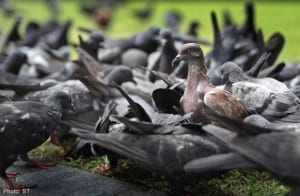Foot deformities are ubiquitous in urban pigeons – why? As you’ll know if you’ve spent any time watching the pigeons of towns and cities, something like one in every ten (or more) has missing or partial toes, or swollen toes, or other pedal deformities of some sort. And then there are really extreme individuals – the ones that are missing feet altogether.
Poor footless urban pigeon, encountered close to Kew train station. The right foot is completely absent; the left one had at least one toe, curled round such that the bird was walking on the toe’s lateral side. Photo by Darren Naish.
I’m talking here about the domestic form of Columba livia, the so-called Rock pigeon or Rock dove. And, while I’ve only noticed deformed pigeons here in the UK, it certainly isn’t a UK-only thing, as continental European and North American [UPDATE: and South American] people will confirm.
The bird in the photos here was able to fly around and feed itself, and it might be broadly described as ‘healthy’. However, note that it’s in pretty poor condition. The feathers on its head and neck looked terrible and its rectrices (the big tail feathers) were frayed and shabby. I reckon this is partly due to an inability to groom and scratch itself: obviously, birds use their feet to reach parts that they can’t get to with the bill.
The impact of this is more than cosmetic, since birds with a poorly maintained or unrepaired plumage are disadvantaged in flight relative to tidier individuals, and less able to keep themselves warm and waterproofed. And a bird that isn’t able to groom parts of its plumage is also at risk of being unable to keep on top of parasites like ticks and feather mites (see the ‘pigeon’s eye view’ Tet Zoo article linked to below). And, as has been demonstrated through various experiments, birds with shabby-looking plumage are less attractive as mates (Clayton 1990), so a bad-looking pigeon is likely to be a non-breeding pigeon. It’s also worth noting that (like many animals), pigeons preferentially use one foot more than the other as goes the way they land and perch and sit and so on (Fisher 1957), so individuals that lose or damage their preferred foot might end up being doubly disadvantaged (imagine being right-handed, and then having to rely only on your left hand for evermore). I don’t know how concerned people are about the emotional well-being of animals like urban pigeons (or how far they’re prepared to go in admitting that non-human animals have feelings and states of mind), but I think we can be fairly confident that the most severely deformed of these birds are – at least at times – miserable, unhappy and frustrated.
Several ideas have been put forward to explain the many foot problems seen in urban pigeons. Some probably lose toes after getting them tangled in litter or anti-pigeon netting, or after they’ve injuries received from anti-pigeon spikes installed on signs and ledges. Fine wire, string, cotton thread and even human hair can all cause problems for birds when caught on or around digits, and some people say that interaction with fine thread and string and so on is the primary cause of pigeon foot damage. It’s also sometimes suggested that the deformities result from infections received after standing on excrement, and also that the birds become damaged through interaction with chemicals used on roofs and building stone. But the ‘chemical injury’ idea is unlikely to be correct, since (A) exactly what sort of chemicals are we talking about here, and why have they been used on buildings in the first place?, and (B) a chemical would basically have to be a powerful acid or alkaline agent (hydrochloric acid, or a very strong bleach) before it might damage a bird’s feet. For completeness, note that hereditary deformities like those reported for some captive populations of other pigeon species (Flach & Cooper 1991) might also explain some of the abnormalities observed in urban pigeons.
Other hazards that might affect an urban pigeon. At left: voracious park-dwelling pelicans! (photo: PA). At right: deceased Wood pigeon (Columba palumbus) following encounter with motor vehicle; note ‘terror-moulted’ lack of rectrices. Photo by Darren Naish.
Pigeons are not, of course, the only birds that end up with damaged feet. You might recall the foot-lacking Rock pipit Anthus petrosus I featured here recently…
I’ve been photographing pigeons a lot lately, but pigeons of a different species from C. livia. More about that another time. For previous Tet Zoo articles relevant to some of the subjects covered here, see…
About Pigeon Patrol:
Pigeon Patrol Products & Services is the leading manufacturer and distributor of bird deterrent (control) products in Canada. Pigeon Patrol products have solved pest bird problems in industrial, commercial, and residential settings since 2000, by using safe and humane bird deterrents with only bird and animal friendly solutions. At Pigeon Patrol, we manufacture and offer a variety of bird deterrents, ranging from Ultra-flex Bird Spikes with UV protection, Bird Netting, 4-S Gel and the best Ultrasonic and audible sound devices on the market today.
Voted Best Canadian wholesaler for Bird Deterrent products four years in a row.
Contact Info: 1- 877– 4– NO-BIRD (www.pigeonpatrol.ca)

